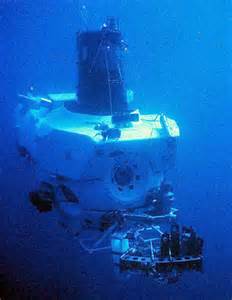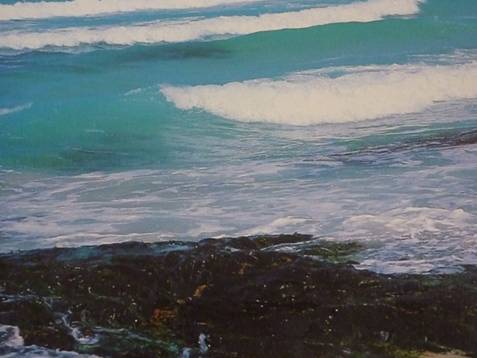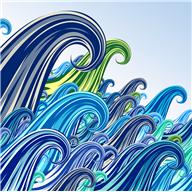
Salty Sam’s Fun Blog for Children
Post Number 14
Oceans of the World
Hello Everyone

l am very lucky that when l look out of my windows l can see the sea.
Every day it looks different; it changes its mood depending on what the weather is like and so the scenery is always changing! ![]()
And of course, when there is a beautiful sunset, l get the best view of it that you can get because there are no other buildings in the way!
ln my last post, l was telling you about how the tides work. There are two high tides a day but not always at exactly the same time each day.
When you are a sailor, you need to know about how the tides work because it is too difficult sometimes to take a little boat out of a harbour if the tide is flowing against you.
You also need to know how to navigate. That means finding your way about on the sea. lt is very different from using a map on the land.
On land you can usually see different things around you. There are even roads with names and signposts, but on the sea of course you are surrounded by water.
So when travelling across the sea on a boat, you can use a radar which shows you what is around you and also a global positioning system (GPS) which tells you where you are. You also have ships’ charts (maps of the sea) that you can use to help you to plan your journey.
Throughout history, travelling on water was one of the easiest ways to get about, especially between countries (as long as you could find your way).
Over 70% of the Earth’s surface is covered by ocean, and it provides 99% of the world’s living space! There is a bigger variety of creatures in the sea than on the land.
The biggest creature is the blue whale which grows up to 30m, the biggest fish is the whale shark which grows up to 20 metres and the smallest creatures are plankton. They are animals that are so small that you can’t even see them without a microscope! This is what we call microlife. The cooler the water the more plankton there are, which is why tropical waters are so clear. Funnily enough whale sharks eat plankton – the biggest fish eats the smallest creatures!
People have been exploring under the sea for 150 years but we still know less about the life deep in the ocean than we do about the surface of the moon.
At the deepest point the ocean is 7 miles deep and for people to go there they need a very strongly-built submarine otherwise the pressure of the water would squash it – and them!
The smallest and shallowest ocean is the Arctic Ocean. lt is at the top of the world. A lot of whales go there to feed.
lf l look out of my lighthouse one way, l can see Rocky Bay on the mainland and on the other side l can see the Atlantic stretching far off into the distance.
The Atlantic Ocean is the second largest ocean in the world after the Pacific (which goes nearly half way around the world) and the hottest ocean is the lndian Ocean.
ln fact, the seabed under the Atlantic Ocean is moving and so the Atlantic is getting bigger by one centimetre every year. New York is getting further away from me.
Maybe that is why airfares keep going up! ![]()
Bye bye everyone – don’t forget to subscribe to my blog!
Love and kisses
Salty Sam

www.christina-sinclair.com


Bill and Bob’s Joke of the Week ![]()
![]()
Bob: What did the Atlantic Ocean say to the Pacific Ocean when they met?
Bill: l don’t know. What did it say?
Bob: Nothing, it just waved!

Salty Sam © Christina Sinclair 2015
Unauthorized use and/or duplication of material from this blog without express and written permission from this blog’s author and owner is strictly prohibited.
Links may be used to www.christina-sinclair.com

Picture Gallery

A whale shark

A whale shark

Plankton

Deep sea submersible
(photo by NOAA)

A ship’s radar circles round to pick up data
 A radar screen inside a ship
A radar screen inside a ship

Oceans can have many moods and colours

The National Maritime Museum at Greenwich charts the history of life at sea

The front door is flanked by two enormous anchors

There is a special gallery just for children ![]()


 THE SALTY SAM NEWS DESK
THE SALTY SAM NEWS DESK

Every morning my alarm clock wakes me up and I jump out of bed (unless it is very cold and then it takes me longer ![]() ).
).
I go over to the window and open the curtains to see what the weather is like.
Some people have a garden outside their window and through the seasons it is always changing.
But the view from my window is always changing too depending on the mood of the sea and the sky.
The sea and sky can be many different colours and textures depending on what weather is blowing my way that day. At the moment the sea is quite calm.

Then I go to switch the light at the top of my lighthouse off, unless it is foggy in which case the light stays on and the fog horn has to be put on as well!
(If it is foggy in the evening and I have the foghorn on all night, I wear earplugs so that I can get some sleep!)
Then the next job is to give Barney my parrot his breakfast and make mine. I nearly always have purple porridge which is porridge and blackcurrant jam mixed together.
I am the only lighthouse man left in these parts.
The lighthouses in Britain have largely become tourist attractions now. Personally I can see their appeal! And what children love most about them is being able to blow the foghorn. (They should try sleeping with it on all night! ![]() )
)
In modern times many fog horns have been replaced by electronic signals.
But there are places in the world where lighthouses are being manned again like in Canada. ![]()

It is so important for everyone that the seas everywhere remain clean and healthy. Everyone can do their bit to ensure this happens whether you own a business, own a boat, live on a river or just visit the beach from time to time.
Always dispose of rubbish carefully. Plastic bags especially are one of the worst things to end up in the sea.
If you want to learn more about how we can all look after the oceans or help with marine conservation projects, please visit the Sea-changers’ website where there is lots of advice.
You can help out with their projects by donating your empty ink cartridges which is a really good way of recycling.
Just go to this website to find more details. ![]()
https://www.sea-changers.org.uk/get-involved

And if you would like to see some beautiful pictures of just some of the many species of creature that live in the oceans of the world, just click on this link to go to one of my Pinterest boards.
https://www.pinterest.com/TheSaltySamBlog/under-the-sea/


Me at my desk writing my blog

*********************
*********************


Quick Quiz
What do the following phrases mean?
- Davy Jones’ locker
- a sea shanty
- the sun is over the yard arm
- sail before steam
- Clear the decks!
- someone is at a low ebb
- Watch your wash!


BLOW MY FOGHORN!!!

PLUS
Salty Sam fans can join in with their comments and share them with children all over the world. You will need permission if you are not an adult.
Enter your e-mail address to subscribe to my blog and receive new Salty Sam Blog Posts for free by e-mail every Fun Friday. Your address will be kept private and will not be shared with any third party.
Sign me up at the side bar




lt’s the Weekend!

HOW TO MAKE MY OCEAN SCENE JUMPER
Last week, I gave you the knitting pattern for some mittens, and the week before that a hat, and as promised, this week is the pattern for a jumper to match!
I love this new outfit that Auntie Alice has knitted for me. I really think it goes well with my eyes. ![]()
PLEASE NOTE YOU WILL NEED 100G OF THE SAME COLOUR BLUE FOR THE JUMPER, HAT AND MITTENS TO MATCH.
OCEAN JUMPER
FRONT AND BACK (KNIT TWO THE SAME)
Using 3½mm knitting needles and blue dk yarn cast on 50 sts
K3 (p2, k2) rep last 4 sts until 3 sts remain p3
Rep this row 7 times (8 row ribbing)
Change to 4mm knitting needles
Increase 1 st at each end of the next 2 rows of stocking stitch
(knit 1 row purl 1 row)
On these 52 sts continue as follows
K3 white (k4 blue, k2 white) repeat last 6 sts until 7 sts remain, k4 blue
k3 white
(p4 white, p2 blue) repeat last 6 sts until 4 sts remain, p4 white
K3 blue (k4 white, k2 blue) repeat last 6 sts until 7 sts remain, k4 white
k3 blue
P1 white p3 blue (p2 white, p4 blue) repeat last 6 sts until 6 sts remain
p2 white, p3 blue, p1 white
Repeat last 4 rows once
Stocking stitch 40 rows starting with a knit row
Cast off 12 sts in the next 2 rows (28 sts)
Change to 3½mm knitting needles
K3 (p2, k2) repeat last 4 sts until 5 sts remain, p2 k3
P3 (k2, p2) repeat last 4 sts until 5 sts remain, k2 p3
Repeat last 2 rows 3 times (8 rows ribbing)
Cast off loosely rib-wise
SLEEVES (KNIT TWO THE SAME)
Using 3½mm knitting needles and blue dk yarn cast on 40 sts
K3 (p2, k2) repeat last 4 sts until 5 sts remain, p2 k3
P3 (k2, p2) repeat last 4 sts until 5 sts remain, k2 p3
Repeat the last 2 rows 3 times (8 rows ribbing)
Change to 4mm knitting needles
Stocking stitch 10 rows
K3 white (k4 blue, k2 white) repeat last 6 sts until 1 st remains, k1 white
(p4 white, p2 blue) repeat last 6 sts until 4 sts remain, p4 white
K3 blue (k4 white, k2 blue) repeat last 6 sts until 7 sts remain, k4 white
k3 blue
P1 white p3 blue (p2 white, p4 blue) repeat last 6 sts until 6 sts remain,
p2 white, p3 blue, p1 white
Repeat last 4 rows once
Stocking stitch 14 rows
Cast off loosely
Now you can embroider a sea scene on the jumper pieces using chain stitch, back stitch and French knots above the waves you have knitted before putting the pieces together. Auntie Alice embroidered a whale and some clouds and seagulls on mine but you can do anything you want.
TO MAKE UP
Use over-sewing on the ribbing (wrong sides together on cuffs because they will be turned back) and running stitch or back stitch along the stocking stitch.
Sew along the shoulders and neck (but only 2cm/1 inch of right shoulder to give room for Sam’s head when dressing).
Sew tops of sleeves to shoulders, side and under arm seams and sew a snap fastener to the corners of the collar on the outside so that they will not be seen when it is turned over.
TIP
When you wash your jumpers, it is a good idea to wash them inside out.



Please note that the material on this blog is for personal use or for use in classrooms only.
It is a copyright infringement and, therefore, illegal under international law to sell items made with these patterns.
Use of all of the toys and projects on this blog is at your own risk.
©Christina Sinclair Designs 2015

www.christina-sinclair.com



Quick Quiz Answers
- Davy Jones’ locker
- a sea shanty
- the sun is over the yard arm
- sail before steam
- Clear the decks!
- someone is at a low ebb
- Watch your wash!
- lt means the bottom of the sea.
- This was a type of song sung by sailors when they were working. Different songs have different rhythms to match different jobs like raising sails or pulling ropes. Different jobs are done at different speeds and a team of men needed to work together and at the same pace.
- Yardarms were the horizontal timbers on masts that the big sails where hung on. This phrase means after 11 am when the sun rises high enough in the sky to be seen over the top of the sails – but sometimes nowadays people mean after 5pm.
- Sailing boats have right of way on the water before boats with engines because boats with engines are more controllable.
- This was something said when a warship was preparing to go into battle. ln everyday life, it means to clear up in preparation to start a project.
- This is when a person is feeling very sad and lacking in energy.
- Boats cause disturbance in the water; this wake can tip over smaller boats or cause damage to river banks if it is violent.

Sail before steam

A yard is a spur on a mast from which sails are set

A picture of the bow of a boat cutting through the calm water of a river
The wake of a boat is the disturbance the boat causes in the water
The wake travels out in a triangular shape


Love and kisses to you too Salty Sam.
🙂
Hello Salty Sam. I read you blog every week. It is fantastic.
I love your blog Salty Sam. I think it is great!
Thank you.
You should take part in a contest for one of the best blogs on the web. I will recommend this site!
Hello Salty Sam
You have a fine blog here – very interesting!
Thank you Paul.